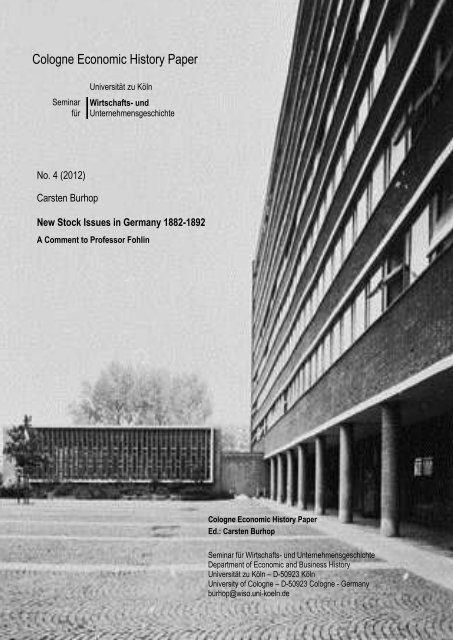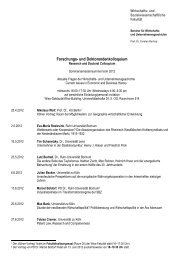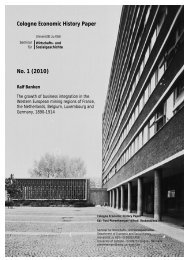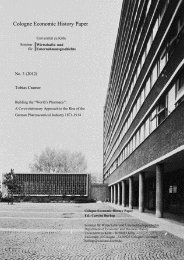Cologne Economic History Paper - Seminar für Wirtschafts- und ...
Cologne Economic History Paper - Seminar für Wirtschafts- und ...
Cologne Economic History Paper - Seminar für Wirtschafts- und ...
You also want an ePaper? Increase the reach of your titles
YUMPU automatically turns print PDFs into web optimized ePapers that Google loves.
<strong>Cologne</strong> <strong>Economic</strong> <strong>History</strong> <strong>Paper</strong><br />
<strong>Seminar</strong><br />
für<br />
Universität zu Köln<br />
<strong>Wirtschafts</strong>- <strong>und</strong><br />
Unternehmensgeschichte<br />
No. 4 (2012)<br />
Carsten Burhop<br />
New Stock Issues in Germany 1882-1892<br />
A Comment to Professor Fohlin<br />
<strong>Cologne</strong> <strong>Economic</strong> <strong>History</strong> <strong>Paper</strong><br />
Ed.: Carsten Burhop<br />
<strong>Seminar</strong> für <strong>Wirtschafts</strong>- <strong>und</strong> Unternehmensgeschichte<br />
Department of <strong>Economic</strong> and Business <strong>History</strong><br />
Universität zu Köln – D-50923 Köln<br />
University of <strong>Cologne</strong> – D-50923 <strong>Cologne</strong> - Germany<br />
burhop@wiso.uni-koeln.de
2<br />
<strong>Cologne</strong> <strong>Economic</strong> <strong>History</strong> <strong>Paper</strong><br />
<strong>Seminar</strong><br />
für<br />
Universität zu Köln<br />
<strong>Wirtschafts</strong>- <strong>und</strong><br />
Unternehmensgeschichte<br />
No. 4 (2012)<br />
New Stock Issues in Germany, 1882-1892<br />
A Comment to Professor Fohlin<br />
Carsten Burhop<br />
<strong>Cologne</strong> <strong>Economic</strong> <strong>History</strong> <strong>Paper</strong><br />
Ed.: Carsten Burhop<br />
<strong>Seminar</strong> für <strong>Wirtschafts</strong>- <strong>und</strong> Unternehmensgeschichte<br />
Department of <strong>Economic</strong> and Business <strong>History</strong><br />
Universität zu Köln – D-50923 Köln<br />
University of <strong>Cologne</strong> – D-50923 <strong>Cologne</strong> - Germany<br />
burhop@wiso.uni-koeln.de
3<br />
New Stock Issues in Germany, 1882-1892<br />
A Comment to Professor Fohlin<br />
Carsten Burhop *<br />
Abstract:<br />
In a recent paper published in the Journal of <strong>Economic</strong> <strong>History</strong>, Professor Caroline<br />
Fohlin investigates the spread earned by <strong>und</strong>erwriters in conducting IPOs at the<br />
Berlin Stock Exchange between 1882 and 1892. According to Professor Fohlin,<br />
<strong>und</strong>erwriters acquired new shares at par value from issuers and sold off at much<br />
higher prices to investors, earning on average 32 percent. I provide evidence on the<br />
basis of archival material that Professor Fohlin overestimates the <strong>und</strong>erwriters’<br />
return, since the spread was more or less equally shared between <strong>und</strong>erwriter and<br />
issuer. Moreover, my findings suggest that the spread varied over time due to<br />
changes in corporate law.<br />
JEL-Classification:<br />
N 23, G 14, D 82<br />
Keywords:<br />
Initial public offerings; banks; stock markets; Germany<br />
* Burhop is at <strong>Seminar</strong> für <strong>Wirtschafts</strong>- <strong>und</strong> Unternehmensgeschichte, Universität zu Köln & Max-Planck-Institut zur<br />
Erforschung von Gemeinschaftsgütern, Bonn; email: burhop@wiso.uni-koeln.de. The author would like to thank to Sibylle<br />
Lehmann for critical comments. Financial support of Deutsche Forschungsgemeinschaft is gratefully acknowledged.
4<br />
In a recent paper, Professor Caroline Fohlin investigates the <strong>und</strong>erpricing of initial public offerings<br />
(IPOs) and seasoned equity offerings (SEOs) at the Berlin Stock Exchange between 1882 and 1892. 1<br />
One of her key conclusion is that “<strong>und</strong>erwriters directly reaped profits from pricing their purchase of new<br />
issues below market value”. 2 According to Professor Fohlin, German <strong>und</strong>erwriters could profit from<br />
asymmetric information among issuers, <strong>und</strong>erwriters, and investors by taking the spread between the<br />
price the <strong>und</strong>erwriter paid to issuers and the price at which they sold off to investors. 3 This price<br />
difference is called ‘<strong>und</strong>erwriter premium’. The proxy used to measure the <strong>und</strong>erwriter premium is the<br />
percentage difference between the offering price and the par value of a share. 4 Professor Fohlin<br />
calculates from a large sample of IPOs that the average <strong>und</strong>erwriter premium was 32.46 percent.<br />
In contrast to substantial returns for <strong>und</strong>erwriters, initial returns for first investors were, compared to<br />
modern data, very low and averaged only 7.23 percent. This finding of low initial returns for first<br />
investors confirms the established view from the literature: Anja Weigt and Carsten Burhop already<br />
calculate initial returns of about five percent for the period 1882 to 1913. 5 Moreover, Burhop computes<br />
initial returns of 0.5 percent for the period 1870 to 1884 and 4.4 percent for the period 1884 to 1896. 6<br />
Thus, the distribution of the money left on the table between <strong>und</strong>erwriters and investors was different in<br />
Germany between 1882 and 1892 – <strong>und</strong>erwriters (i.e., banks) were the winners instead of first<br />
investors, whereas nothing changed for issuers. I argue from case studies documented in the files of<br />
various banks that issuers received a substantial fraction of the <strong>und</strong>erwriter spread. Therefore, banks<br />
were not the only winners. Moreover, I argue that Professor Fohlin misses a lot of dynamics, since the<br />
legal framework for the valuation of issues changed substantially due to the 1884 corporate law reform.<br />
The typical IPO at the late 19 th century German stock market involved several steps. In most of the<br />
cases, an already existing firm changed its legal form to become a joint-stock company – usually to<br />
allow former owners to diversify their investment, to retire due to old age, or to raise additional f<strong>und</strong>s for<br />
investment. 7 To incorporate, the owner of an existing firm transfers all assets (buildings, machinery etc.)<br />
to the newly fo<strong>und</strong>ed joint-stock company and he receives shares at face value 8 in return. In addition to<br />
1 Fohlin, „Asymmetric information“.<br />
2 Fohlin, „Asymmetric information“, p. 653.<br />
3 Fohlin, „Asymmetric information“, pp. 638-639.<br />
4 Fohlin, „Asymmetric information“, p. 642. Professor Fohlin admits that this is not necessarily the profit of the <strong>und</strong>erwriter<br />
since the <strong>und</strong>erwriter may pay more than the par value of a share to the issuer. Nonetheless, she uses this variable in her<br />
regression analysis and her conclusions are drawn from the regressions, see Fohlin “Asymmetric information”, p. 642-643<br />
and footnote 27 on page 647.<br />
5 Weigt, Der deutsche Kapitalmarkt and Burhop, „Die Technik“.<br />
6 Burhop, „The <strong>und</strong>erpricing”.<br />
7 See Lotz, Die Technik des Emissionsgeschäfts, Obst, Das Bankgeschäft, p. 322-330 and p. 339-350, and Riesser,<br />
Großbanken, pp. 280-295 for contemporary textbooks treatments of IPOs.<br />
8 The face value of a share was usually 1,000 marks (about $240). Shares were quoted in percent of face value.
5<br />
the assets of the former company, other incorporators – the minimum number of incorporators<br />
according corporate law was five – can put new money (usually in cash) into the new joint-stock<br />
company and receive shares at face value in return. Typically, these ‘cash-incorporators’ were banks<br />
(i.e., the <strong>und</strong>erwriters). The shares of the new joint-stock company are now all owned by the<br />
incorporators (the former owner and cash-incorporators). In a next step, the incorporators sell all or – in<br />
most of the cases – some of the shares to an <strong>und</strong>erwriting syndicate. The <strong>und</strong>erwriter syndicate<br />
subsequently offers the shares to first (outside) investors at the stock market, often at a fixed offering<br />
price.<br />
During the process of incorporation, the opening balance sheet of the new corporation is set up.<br />
According to the German corporate law in force from June 1870 until July 1884, all assets have to be<br />
valued according the current market value. Since most assets do not have a market (e.g., existing<br />
buildings, old machinery etc.) the value typically was the best guess of the incorporator. The only<br />
restriction contained in the law referred to securities. For securities, the current market price was the<br />
maximum book value. 9 In practice, the former owners of a firm sold the assets of the firm at a very<br />
favourable price to the new joint stock company and the <strong>und</strong>erwriters acquired the shares at par value<br />
from the joint stock company. 10<br />
According to Walther Lotz, author of the standard textbook on the <strong>und</strong>erwriting business, this practice<br />
changed in 1884 due to the new corporate law. 11 The new law specified that all securities and other<br />
assets having an exchange price (e.g., securities, metals, grain etc.) have to be valued to the market<br />
price but not higher than the historic purchase price. In addition, all other assets have to be valued not<br />
higher than the historic purchase price. Furthermore, depreciations have to be booked for all plant and<br />
equipment to reflect reductions in value due to use since the assets have been bought. 12 Thus, the 1884<br />
corporate law reform marked the move from the mark-to-market accounting principle to the lowest value<br />
9 See §§ 31 and 229a of the 1870 ADHGB.<br />
10 Riesser, Großbanken, p. 283-284 („Eine materielle Nachprüfung der für die Einbringung von Sacheinlagen (Apports)<br />
festgesetzten Preise, ferner der für die Gründung <strong>und</strong> deren Vorbereitung gewährten Vorteile <strong>und</strong> der erzielten<br />
Zwischengewinne bestand eben nicht, das Agio aber der von der Gesellschaft ausgegebenen Aktien floß nicht, wie heute,<br />
dem Reservefonds der Gesellschaften, sondern den Vorbesitzern zu, welche es in Anrechnung für ihre Sacheinlagen<br />
(Apports) erhielten.“).<br />
11 „Seit dem neuen Aktiengesetz vom 18. Juli 1884 hat sich dies wesentlich geändert. Daß bloß aus gemeinnütziger Absicht<br />
Gründungen unternommen werden, darf man auch jetzt nicht verlangen <strong>und</strong> erwarten. Was jedoch die Übernahme der<br />
bisherigen Werte, der sogenannten Illaten, anbetrifft, so ist es seitdem wesentlich erschwert, ja fast unmöglich geworden,<br />
durch zu hohe Taxierungen derselben einen Gewinn zu erlangen.“ (Lotz, Die Technik des Emissionsgeschäfts, p. 42).<br />
12 See §§ 185a and 239b of the 1884 HGB.
6<br />
accounting principle. 13 Furthermore, from 1884 onwards, external auditors appointed by the local<br />
chamber of commerce audited the first balance sheet of the new corporation. 14<br />
To put a long story short: before 1884, incorporators sold assets at inflated prices to the new joint stock<br />
company and they then sold the shares at par value to the <strong>und</strong>erwriters. After 1884, incorporators sold<br />
assets at comparatively low prices to the new joint stock company and then sold the shares above par<br />
value to the <strong>und</strong>erwriters.<br />
According the calculations presented by Professor Fohlin, the incorporators sell all shares at face value<br />
to the <strong>und</strong>erwriting syndicate. Therefore, the difference between the offering price and face value is<br />
considered to reflect the spread earned by the banks. One major advantage of this approach is the fact<br />
that both, the face value and the offering price, are easily observable, whereas the price actually paid by<br />
the <strong>und</strong>erwriting syndicate to the incorporator is only stated in a contract between the parties involved.<br />
Unfortunately, these contracts are only – and in practice rarely – available in archives. I claim, in<br />
accordance with 19 th century experts, that incorporators sold off to <strong>und</strong>erwriters at par until 1884 and<br />
above par from 1884 onwards. The empirical content of this hypothesis shall be substantiated by<br />
archival evidence.<br />
First example: The Accumulatoren-Fabrik AG was established as a joint stock company with a capital of<br />
4.5 million marks in July 1890, based on the private firm (Offene Handelsgesellschaft)<br />
Accumulatorenfabrik Tudor’schen Systems Müller & Einbeck, which was established in 1887. The jointstock<br />
company went public on 8 November 1894 in Berlin and Frankfurt. The issue was <strong>und</strong>erwritten by<br />
Deutsche Bank, Berliner Handelsgesellschaft, Nationalbank für Deutschland, Gebr. Delbrück, Jacob<br />
Landau, Gebr. Sulzach, and Ernst Osthaus. The issue price was 140 percent, the full share capital of<br />
4.5 million marks was admitted to the stock exchange, but only 3.026.000 marks were offered to the<br />
public. 15 According to Professor Fohlin, the <strong>und</strong>erwriter spread was 40 percent – the difference between<br />
the offering price and the par value. The files of the lead <strong>und</strong>erwriter Deutsche Bank show that the<br />
13 Lotz, Die Technikg des Emissionsgeschäfts, p. 48 figured out that the difference between offering price and par value<br />
gives first investors a fair picture about the joint profit of incorporator, issuer, and <strong>und</strong>erwriter. („Wenn gegenwärtig nicht<br />
mehr im Verkaufspreise der vom Vorbesitzer eingebrachten Gegenstände <strong>und</strong> der Beteiligung der Gründer an diesem<br />
Gewinn, sondern im Verkaufspreise der Aktien der Vorteil gesucht wird, so ist die Folge, daß bei der heutigen Sachlage<br />
jeder einzelne Käufer sich ziffernmäßig klar machen kann, wieviel er dem Vorbesitzer <strong>und</strong> dem Konsortium durch Aufgeld<br />
zu verdienen gibt, während bei der früheren Praxis der Käufer, falls er überhaupt Gr<strong>und</strong> zu Mißtrauen hatte, gar nicht<br />
kontrollieren konnte, um wieviel die eingebrachten Gegenstände zu hoch bewertet waren.“<br />
14 Riesser, Großbanken, p. 287 („Es kam hinzu, daß von 1884 ab die absichtliche oder grob fahrlässige Überbewertung von<br />
Apports sehr erschwert, jedes Verstecken der Namen der Gründer oder Gründergenossen aber <strong>und</strong> jedes Verheimlichen<br />
von Gründer- oder Zwischengewinnen schon nach Lage der Gesetzgebung so gut wie ausgeschlossen war <strong>und</strong> daß die<br />
Feststellung der Höhe der für die eingebrachten oder übernommenen Vermögenswerte gewährten Aktien oder<br />
Vergütungen einer dreifachen materiellen Nachprüfung zivil- <strong>und</strong> strafrechtlich in strengster Weise verantwortlicher<br />
Personen unterlag.“).<br />
15 Prospectus of Accumulatoren-Fabrik AG, Historical Archive Deutsche Bank, file no. SG 32/1.
7<br />
banks did not acquire the shares at par value and that different banks paid different prices. The lead<br />
<strong>und</strong>erwriter Deutsche Bank acquired the shares at an average price of 109.31, the Berliner<br />
Handelsgesellschaft paid 112.5, and the private banks included in the syndicate paid an average price<br />
of 108.65. 16<br />
Second example: Anglo-Continentale-Guanowerke AG Hamburg. The firm was incorporated as a joint<br />
stock company during October 1883, based on the established private firm Ohlendorff’sche<br />
Guanowerke. The joint-stock company had a capital of 16 million marks, divided into 16,000 shares with<br />
a par value of 1,000 marks each. The owner of the private firm, Ohlendorff, received 5,248 shares for<br />
his old company and paid up the remaining share capital in cash. During the same month, Ohlendorff<br />
sold 10,000 shares to a banking syndicate at a price of 125 percent. Members of the syndicate were the<br />
Norddeutsche Bank, a large provincial bank based in Hamburg, and the Berlin based banking house<br />
Bleichröder. During August 1888, 12,500 shares were admitted to the stock exchanges in Berlin and<br />
Hamburg and they were offered to investors at a price of 125 by a syndicate composed of Bleichröder,<br />
Norddeutsche Bank, L. Behrens (a private bank from Hamburg), and Darmstädter Bank für Handel <strong>und</strong><br />
Industrie. For their service, the banks received a fee of 125,000 marks from the issuer. 17 Thus, the<br />
<strong>und</strong>erwriter spread was close to zero.<br />
Third example: Sürther Maschinenfabrik AG, a mechanical engineering company based in <strong>Cologne</strong>.<br />
Lead <strong>und</strong>erwriter was the <strong>Cologne</strong> banking house Oppenheim, co-<strong>und</strong>erwriters were the private banking<br />
houses Bethmann and Kahn. The Sürther Maschinenfabrik had a capital of 1.6 million marks divided<br />
into 1,600 shares. The former owner of the Maschinenfabrik kept 500 shares and he sold 1,100 shares<br />
at a price of 125 percent to the syndicate. In May 1889, the syndicate offered the shares at a price of<br />
140 percent to the public. 18<br />
The three examples, all taken from the period covered by Professor Fohlin, illustrate that banks paid<br />
more than face value to the issuer. To assess if this is a general pattern, the archival records of<br />
Deutsche Bank, Dresdner Bank, Commerzbank, Berliner Handelsgesellschaft, Bethmann, and Sal.<br />
Oppenheim jun. & Cie. have been screened. Unfortunately, the number of surviving <strong>und</strong>erwriter<br />
contracts for IPOs is pretty small: 22 contracts covering the period 1872 to 1914 have been discovered<br />
(see Table 1). Nonetheless, the contracts show a pattern consistent with the narrative of 19 th century<br />
experts: During the pre-1884 period, all issues were sold at par value to the <strong>und</strong>erwriting syndicate,<br />
16 Letters Deutsche Bank to Berliner Handelsgesellschaft, 22 July 1890 and 26 July 1890. Historical Archive Deutsche Bank,<br />
file no. S 0042.<br />
17 Frankfurt City Record Office, files of Bethmann private bankers, file V 665. Historical Archive Deutsche Bank file K1/201.<br />
Historical Archive Deutsche Bank, file SG 2/32.<br />
18 Frankfurt City Record Office, files of Bethmann private bankers, files V 568 and V 569.
8<br />
whereas <strong>und</strong>erwriters paid on average 119.6 percent of par value after 1884. During the pre-1884<br />
period, <strong>und</strong>erwriters offered shares – on average – at 111.8 percent of par value to investors. Thus, the<br />
<strong>und</strong>erwriter spread was 11.8 percent. During the post-1884 period, <strong>und</strong>erwriters offered the shares at an<br />
average price of 138.4 percent. Consequently, the <strong>und</strong>erwriter spread was 15.7 percent. The averages<br />
over the entire period 1872 to 1914 were 113.4 (acquisition price) and 129.9 (offer price). Thus, the<br />
<strong>und</strong>erwriter spread was 14.6 percent. Furthermore, I would like to point out that the difference between<br />
offering price and par value over the entire period was 29.9 percent in my sample – pretty close to<br />
Professor Fohlin’s estimate of 32.46 percent. However, the spread was shared between issuer and<br />
<strong>und</strong>erwriter. Thus, the picture of powerful banks exploiting issuers and first outside investors is not<br />
entirely correct. It seems that IPOs generated more or less equal returns for issuers, <strong>und</strong>erwriters, and<br />
first investors.
9<br />
TABLE 1: IPO CONTRACT DETAILS, 1872-1914<br />
Name of issue<br />
Year of<br />
issue<br />
Acquisition<br />
price of<br />
<strong>und</strong>erwriting<br />
syndicate<br />
Offering<br />
price<br />
Waren-Credit Anstalt 1872 100 110 Norddeutsche Bank<br />
Lead <strong>und</strong>erwriter Source 19<br />
HADB K1 850;<br />
HADB K1 851<br />
Hanseatische Baugesellschaft 1872 100 108 Norddeutsche Bank HADB K1 654<br />
Dortm<strong>und</strong>er Union 1872 100 110 Discontogesellschaft OA AXIV 205<br />
Hamburger Bankverein 1872 100 105 Berliner Bankverein BA V 168<br />
Gelsenkirchener Bergwerk 1873 100 115 Discontogesellschaft HADB K1 645<br />
Hibernia & Shamrock 1873 100 115<br />
Berliner<br />
Handelsgesellschaft<br />
HADB K1 646<br />
Deutsche Verlagsanstalt 1881 100 120 Bankhaus Bethmann BA V 753<br />
Anglo-Continentale Guanowerke 1888 125 125 Norddeutsche Bank<br />
Straßburger Druckerei 1888 128 145 Bankhaus Bethmann BA V 723<br />
Sürther Maschinenfabrik 1889 125 140 Sal. Oppenheim<br />
Allgemeine Elsässische<br />
Bankgesellschaft<br />
Accumulatorenfabrik 1894 109 140<br />
Elika Gesellschaft für elektrische<br />
Anlagen<br />
Deutsche Gesellschaft für<br />
elektrische Unternehmungen<br />
HADB K1 201;<br />
HADB SG 2/32; BA<br />
V 665<br />
BA V 585; BA V<br />
569<br />
1890 100 115 Bankhaus Bethmann BA V 103<br />
Berliner<br />
Handelsgesellschaft<br />
1897 100 123 Sal. Oppenheim OA<br />
HADB S 0042;<br />
HADB S 0046<br />
1898 100 134 Erlanger & Söhne BA V 221<br />
Elektrische Licht- <strong>und</strong> Kraftanlagen 1898 100 115 Jacob S.H. Stern BA V 916<br />
Westfälische Eisen-<strong>und</strong> Drahtwerke 1904 100 105 Sal. Oppenheim OA<br />
Hubertus Braunkohlen 1905 139 155 Deutsche Bank OA<br />
Berg- <strong>und</strong> Metallbank 1907 110 127<br />
Berliner<br />
Handelsgesellschaft<br />
BA V 300<br />
Harburger Ölfabriken Fr. Thörl 1908 120 170 Deutsche Bank HADB K 16 123<br />
Th. Goldschmidt 1911 125 127 Discontogesellschaft OA<br />
Farbwerke Rasquin 1912 197 200 Discontogesellschaft OA<br />
Amme, Gieseke & Konegen 1914 116 155 Deutsche Bank HADB K 16 68<br />
19 HADB = Historical Archive of Deutsche Bank. BA = Bethmann archive. OA = Oppenheim archive.
10<br />
References<br />
BA Bethmann Archive stored in the Frankfurt City Record Office, files no.V 103, V 168, V 221, V 300, V<br />
569, V 585, V 665, V 723, V 753, V 916<br />
Burhop, Carsten. „Die Technik des Gründungsgeschäfts in der Hochindustrialisierung“,<br />
Bankhistorisches Archiv 32 (2), 2006, 91-112<br />
Burhop, Carsten. “The <strong>und</strong>erpricing of initial public offerings at the Berlin Stock Exchange, 1870-96,”<br />
German <strong>Economic</strong> Review, 12, no. 1 (2011): 11-32.<br />
Fohlin, Caroline. “Asymmetric Information, Market Power, and the Underpricing of New Stock Issues in<br />
Germany, 1882-1892”, Journal of <strong>Economic</strong> <strong>History</strong> 70, no. 3 (2010): 630-656.<br />
HADB Historical Archive Deutsche Bank, files no. K1/201, K1 645, K1/646, K1/654, K1/850, K1/851,<br />
K16/ 68, K16/123, S 0042, S 0046, SG 2/32.<br />
Lotz, Walther. Die Technik des deutschen Emissionsgeschäfts. Leipzig: Duncker & Humblot, 1890.<br />
Obst, Georg. Das Bankgeschäft, Band 1, Poeschel, Stuttgart 1921<br />
OA Sal. Oppenheim jun. & Cie. Archive, files Dortm<strong>und</strong>er Union, Elika, Farbwerke Rasquin, Hubertus<br />
Braunkohlen, Th. Goldschmitdt, Westfälische Eisen- <strong>und</strong> Drahtwerke.<br />
Riesser, Jacob. Die deutschen Großbanken, 4th Edition, Fischer, Jena 1911.<br />
Weigt, Anja. Der deutsche Kapitalmarkt vor dem Ersten Weltkrieg. Gründerboom, Gründerkrise <strong>und</strong><br />
Effizienz des deutschen Aktienmarktes bis 1914, Fritz Knapp, Frankfurt am Main 2005.








